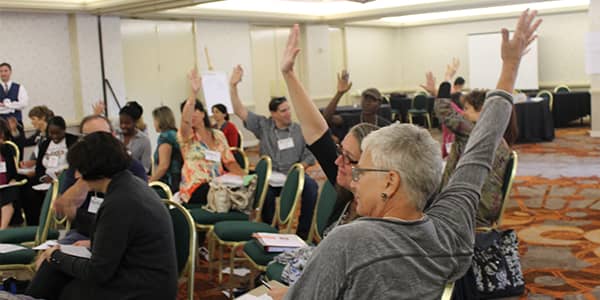Blog

Training that transforms artists and teachers

In a recent blog post for the Washington Post, Alvin Crawford, CEO of Knowledge Delivery Systems, addresses fundamental issues with the current professional development offerings for educators. He cites a 2009 report which found that “when asked about their experience in professional development, ‘most teachers reported that it was totally useless.’” The substantial financial investment the U.S. makes in teacher development ($2.5 billion in 2012 according to U.S. Secretary of Education Arne Duncan) is not meeting the needs of many teachers, or in turn, students.
The Teaching Artist Institute (TAI), did not set out to be a teacher professional development program, but as the program starts its eighth year this fall, it is clear that it is succeeding where many traditional professional development workshops are not. TAI also has gained attention for how it provides teachers with creative and natural tools for implementing Maryland’s Common Core College and Career-Ready Standards through the arts.
TAI is a statewide program made possible through the partnership of the Arts Education in Maryland Schools Alliance, the Maryland State Arts Council, and Young Audiences/Arts for Learning. It was founded to train teaching artists to create curriculum-aligned arts programs for classrooms. Since its start in 2007, the program has graduated more than 110 artists and has repositioned the role of artists in education in Maryland. Teaching artists were once perceived as performers—able to entertain, and perhaps share another culture with students—but they were a distraction from the school day, a break from the classroom. Through TAI, artists have demonstrated the value they bring to the classroom as educators.

See more photos from the 2014-2015 TAI Seminar here!
TAI-trained artists are critical partners to teachers of any subject, using their art form to creatively address the ever-changing curriculum and standards to which teachers are held accountable. TAI fosters partnerships between teaching artists and teachers, requiring artists to collaboratively plan and teach with an assigned teacher. Through this collaboration, teachers experience the gifts a teaching artist brings to the classroom and learn how the arts can be used to engage children in learning. While TAI was not created for teachers, teachers report it improves their own practice of arts integration and reinvigorates their passion for teaching.
In his post, Mr. Crawford shares what teacher professional development needs to entail to be effective for teachers and to positively impact student achievement:
Teacher development studies…have shown over and over again that simply exposing a teacher to a new concept or skill has little to no classroom impact because most professional development opportunities for educators are still lecture style – telling, showing, and explaining how something can be done.
And when the “learning” is finished, we push teachers back into the choppy waters of their classrooms without so much as a life preserver; they’re given very little or ineffective ongoing support from their district.
To be transformative, strategic professional development needs to be 50 hours or more plus less formal and ongoing interaction and peer engagement to refine skills and model successes. It must also be tailored by subject, grade level and type of student.
By developing an effective training program for artists, TAI has also grown to offer a professional development opportunity for teachers which fits Mr. Crawford’s definition of “transformative.” The 70-hour TAI Seminar begins with a three-day workshop, which includes sessions led by master teaching artists and opportunities for participants to develop and share their knowledge in small groups. Pairs of artists and teachers then work independently during the course of several months to co-create an arts residency program which integrates the artist’s expertise with the curriculum and to test and refine their new program by piloting it with students in the teacher’s classroom.
While TAI was not designed to address the teaching practice of educators, it continues to build a community of impassioned artists and teachers who want to work together to transform teaching and learning through the arts.
Learn more about the TAI program and see photos from the 2014-2015 TAI Seminar. Listen and read recent reporting by WYPR, Maryland’s public radio station, on how TAI teacher and artist participants are creatively addressing Common Core through the arts: Meshing Common Core and Arts Standards and Arts and Common Core—a Natural Fit.









